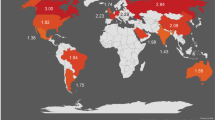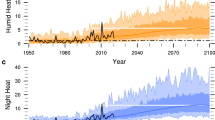Abstract
In 1990, climate scientists from around the world wrote the First Assessment Report of the Intergovernmental Panel on Climate Change. It contained a prediction of the global mean temperature trend over the 1990–2030 period that, halfway through that period, seems accurate. This is all the more remarkable in hindsight, considering that a number of important external forcings were not included. So how did this success arise? In the end, the greenhouse-gas-induced warming is largely overwhelming the other forcings, which are only of secondary importance on the 20-year timescale.
This is a preview of subscription content, access via your institution
Access options
Subscribe to this journal
Receive 12 print issues and online access
$209.00 per year
only $17.42 per issue
Buy this article
- Purchase on Springer Link
- Instant access to full article PDF
Prices may be subject to local taxes which are calculated during checkout

Similar content being viewed by others

References
IPCC Climate Change: The IPCC Scientific Assessment (eds Houghton, J. T., Jenkins, G. J. & Ephraums, J. J.) (Cambridge Univ. Press, 1990).
Bretherton, F. P., Bryan, K. & Woods, J. D. in Climate Change: The IPCC Scientific Assessment (eds Houghton, J. T., Jenkins, G. J. & Ephraums, J. J.) 173–194 (Cambridge Univ. Press, 1990).
Le Treut, H. et al. in IPCC Climate Change 2007: The Physical Science Basis (eds Solomon, S. et al.) 93–127 (Cambridge Univ. Press, 2007).
Pielke, R. A. J. Climate predictions and observations. Nature Geosci. 1, 206 (2008).
IPCC Climate Change 1992: The Supplementary Report to the IPCC Scientific Assessment (eds Houghton, J. T., Callander, B. A. & Varney, S. K.) (Cambridge Univ. Press, 1992).
Kattenberg, A. et al. in IPCC Climate Change 1995: The Science of Climate Change (eds Houghton, J. T. et al.) Ch. 6 (Cambridge Univ. Press, 1995).
Cubasch, U. et al. in IPCC Climate Change 2001: The Scientific Basis (eds Houghton, J. T. et al.) 525–581 (Cambridge Univ. Press, 2001).
Meehl, G. A. et al. in IPCC Climate Change 2007: The Physical Science Basis (eds Solomon, S. et al.) 748–845 (Cambridge Univ. Press, 2007).
Brohan, P., Kennedy, J. J., Harris, I., Tett, S. F. B. & Jones, P. D. Uncertainty estimates in regional and global observed temperature changes: A new data set from 1850. J. Geophys. Res. 111, D12106 (2006).
Hansen, J., Ruedy, R., Sato, M. & Lo, K. Global surface temperature change. Rev. Geophys. 48, RG4004 (2010).
Wigley, T. M. L., Smith, R. L. & Santer, B. D. Anthropogenic influence on the autocorrelation structure of hemispheric-mean temperatures. Science 282, 1676–1679 (1998).
Tsonis, A. A. & Elsner, J. B. The autocorrelation function and human influences on climate. Science 285, 495 (1999).
Wigley, T. M. L., Smith, R. L. & Santer, B. D. Response to: The autocorrelation function and human influences on climate. Science 285, 495 (1999).
Allen, M. R. & Tett, S. F. B. Checking for model consistency in optimal fingerprinting. Clim. Dynam. 15, 419–434 (1999).
Hegerl, G. C. et al. in IPCC Climate Change 2007: The Physical Science Basis (eds Solomon, S. et al.) 663–745 (Cambridge Univ. Press, 2007).
Stone, D. A. et al. The detection and attribution of human influence on climate. Annu. Rev. Env. Resour. 34, 1–16 (2009).
Meehl, G. A. et al. The WCRP CMIP3 multimodel dataset: A new era in climate change research. Bull. Am. Meteorol. Soc. 88, 1383–1394 (2007).
Easterling, D. R. & Wehner, M. F. Is the climate warming or cooling? Geophys. Res. Lett. 36, L08706 (2009).
Santer, B. D. et al. Separating signal and noise in atmospheric temperature changes: The importance of timescale. J. Geophys. Res. 116, D22105 (2011).
Jenkins, G. J. & Derwent, R. G. in Climate Change: The IPCC Scientific Assessment (eds Houghton, J. T., Jenkins, G. J. & Ephraums, J. J.) 329–340 (Cambridge Univ. Press, 1990).
Meinshausen, M. et al. The RCP greenhouse gas concentrations and their extensions from 1765 to 2300. Climatic Change 109, 213–241 (2011).
Hansen, J. et al. in Climate Processes and Climate Sensitivity (eds Hansen, J. E. & Takahashi, T.) 130–163 (AGU Geophysical Monograph 29, Maurice Ewing, Vol. 5, American Geophysical Union, 1984).
Frame, D. J. et al. Constraining climate forecasts: The role of prior assumptions. Geophys. Res. Lett. 32, L09702 (2005).
Stone, D. A., Allen, M. R., Selten, F., Kliphuis, M. & Stott, P. A. The detection and attribution of climate change using an ensemble of opportunity. J. Clim. 20, 504–516 (2007).
Allen, M. R. et al. Warming caused by cumulative carbon emissions towards the trillionth tonne. Nature 458, 1163–1166 (2009).
Knutti, R. & Hegerl, G. C. The equilibrium sensitivity of the Earth’s temperature to radiation changes. Nature Geosci. 1, 735–743 (2008).
Acknowledgements
The authors wish to thank the international RCP Concentration Calculation and Data Group for the historical forcing data, and the UK Met Office Hadley Centre, the University of East Anglia’s Climate Research Unit and the Goddard Institute for Space Studies for global temperature data. M. Allen provided helpful comments on an earlier draft. D.J.F. would like to thank the Oxford Martin School and the Smith School of Enterprise and the Environment for support. D.A.S. would like to acknowledge funding from Microsoft Research with further support from the US Department of Energy’s Office of Science, Office of Biological and Environmental Research and the US National Oceanic and Atmospheric Administration’s Climate Program Office, through the International Detection and Attribution Group.
Author information
Authors and Affiliations
Contributions
D.J.F. and D.A.S. wrote the text and D.A.S. performed the calculations.
Corresponding authors
Ethics declarations
Competing interests
The authors declare no competing financial interests.
Rights and permissions
About this article
Cite this article
Frame, D., Stone, D. Assessment of the first consensus prediction on climate change. Nature Clim Change 3, 357–359 (2013). https://doi.org/10.1038/nclimate1763
Received:
Accepted:
Published:
Issue Date:
DOI: https://doi.org/10.1038/nclimate1763
This article is cited by
-
How well have CMIP3, CMIP5 and CMIP6 future climate projections portrayed the recently observed warming
Scientific Reports (2022)
-
Probabilistic forecasts of near-term climate change: verification for temperature and precipitation changes from years 1971–2000 to 2011–2020
Climate Dynamics (2022)
-
The epistemological status of general circulation models
Climate Dynamics (2018)
-
Assessing temperature pattern projections made in 1989
Nature Climate Change (2017)
-
Look back, looking forward
Nature Climate Change (2017)


